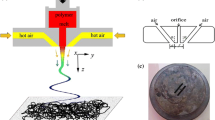Abstract
In order to reduce the fiber diameter and the energy consumption in the melt-blowing process, three new slot dies (slot die with air accelerator, slot die with stabilizers and slot die with extensions) are designed. The airflow fields of these dies have been numerically calculated and experimentally verified. The results reveal that the slot die with stabilizers and slot die with extensions have higher average stagnation temperatures, average air pressure and average turbulent kinetic energy than those of the common slot die. Compared with the common slot die, the slot die with air accelerator could increase the average stagnation temperature on the spinning line, however, its average pressure is reduced and the average turbulent kinetic energy is locally increased. By comprehensively comparing the average stagnation temperature, average air pressure and average turbulent kinetic energy on the spinning lines of these slot dies, the new slot die with stabilizers is the most conducive to the attenuation of the melt-blowing fibers and the reduction of energy consumption. The research in this work can have strong guiding significance for the optimization of die structure and the attenuation of melt-blowing fibers.
Similar content being viewed by others
References
Y. Q. Xu, X. M. Zhang, X. B. Hao, D. F. Teng, T. N. Zhao, and Y. C. Zeng, Chem. Eng. J., 423, 130175 (2021).
D. F. Teng, A. Wahid, and Y. C. Zeng, Polymer, 201, 122609 (2020).
W. L. Han, S. **e, J. Shi, and X. H. Wang, Polym. Eng. Sci., 59, 1182 (2019).
B. W. Zhu, S. **e, W. L. Han, and G. J. Jiang, Fiber. Polym., 22, 1594 (2021).
W. L. Han, G. S. Bhat, and X. H. Wang, Ind. Eng. Chem. Res., 55, 3150 (2016).
X. B. Hao and Y. C. Zeng, Ind. Eng. Chem. Res., 58, 11624 (2019).
Z. F. Wang, C. W. Macosko, and F. S. Bates, ACS Appl. Mater. Inter., 8, 3006 (2016).
H. Zhang, Q. Zhen, Y. Liu, L. Wang, X. Y. Guan, and Y. F. Zhang, J. Ind. Text., 51, 1431 (2020).
A. S. Harpham and R. L. Shambaugh, Ind. Eng. Chem. Res., 35, 3776 (1996).
A. S. Harpham and R. L. Shambaugh, Ind. Eng. Chem. Res., 36, 3937 (1997).
B. D. Tate and R. L. Shambaugh, Ind. Eng. Chem. Res., 43, 5405 (2004).
T. Chen, X. H. Wang, and X. B. Huang, Text. Res. J., 74, 1018 (2004).
X. M. Wang and Q. F. Ke, Polym. Eng. Sci., 45, 1092 (2005).
S. **e and Y. C. Zeng, Ind. Eng. Chem. Res., 51, 5346 (2012).
S. **e, W. L. Han, G. J. Jiang, and C. Chen, J. Mater. Sci., 53, 6991 (2018).
J. J. Jia, S. **e, and C. D. Zhang, ACS Omega, 6, 30012 (2021).
Y. Yang and Y. C. Zeng, Ind. Eng. Chem. Res., 59, 10664 (2020).
Y. D. Wang, C. C. Ji, and J. P. Zhou, e-Polymers, 19, 612 (2019).
C. C. Ji and Y. D. Wang, e-Polymers, 20, 724 (2020).
H. M. Krutka and R. L. Shambaugh, Ind. Eng. Chem. Res., 41, 5125 (2002).
H. M. Krutka, R. L. Shambaugh, and D. V. Papavassiliou, Ind. Eng. Chem. Res., 42, 5541 (2003).
H. M. Krutka, R. L. Shambaugh, and D. V. Papavassiliou, Ind. Eng. Chem. Res., 43, 4199 (2004).
Y. F. Sun and X. H. Wang, J. Text. Inst., 102, 65 (2011).
Y. F. Sun and X. H. Wang, J. Appl. Polym. Sci., 115, 1540 (2010).
X. B. Hao and Y. C. Zeng, Text. Res. J., 89, 3221 (2019).
C. C. Ji, Y. D. Wang, and Y. F. Sun, J. Ind. Text., 50, 1409 (2021).
Y. D. Wang, J. P. Zhou, and X. P. Gao, ACS Omega, 5, 13409 (2020).
Y. D. Wang, Y. P. Qiu, C. C. Ji, X. H. Wang, and F. W. Guan, Text. Res. J., 92, 423 (2022).
Y. D. Wang and X. H. Wang, Polym. Eng. Sci., 54, 110 (2014).
C. C. Ji, K. Y. Zhang, Y. D. Wang, and X. H. Wang, J. Text. Res., 40, 175 (2019).
F. R. Menter, AIAA J., 32, 1598 (1994).
M. A. J. Uyttendaele and R. L. Shambaugh, AIChE J., 36, 175 (1990).
B. R. Shambaugh, D. V. Papavassiliou, and R. L. Shambaugh, Ind. Eng. Chem. Res., 50, 12233 (2011).
V. Bansal and R. L. Shambaugh, Ind. Eng. Chem. Res., 37, 1799 (1998).
N. Hoda, F. Mert, F. Kara, H. G. Atasagun, and G. S. Bhat, Fiber. Polym., 22, 285 (2021).
Acknowledgement
This research was supported by the National Natural Science Foundation of China (No. 11702113), the Open Project Program of Key Laboratory of Yarn Materials Forming and Composite Processing Technology of Zhejiang Province (MTC-2022-2), the Doctoral Fund Program of Guangxi University of Science and Technology (21Z47), the Natural Science Foundation of Inner Mongolia (Grant No. 2021LHMS01003) and Fujian Natural Science Foundation Project (Grant No.2019J01740).
Author information
Authors and Affiliations
Corresponding authors
Additional information
Conflict of Interest
The author(s) declared no potential conflicts of interest with respect to the research, author-ship, and/or publication of this article.
Rights and permissions
About this article
Cite this article
Wang, Y., Jiang, F., Ning, W. et al. Investigation on the Airflow Fields of New Melt-blown Dies with Rectangular Jets. Fibers Polym 23, 2732–2739 (2022). https://doi.org/10.1007/s12221-022-0043-4
Received:
Revised:
Accepted:
Published:
Issue Date:
DOI: https://doi.org/10.1007/s12221-022-0043-4



